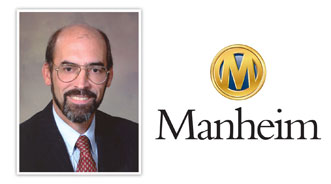Webb: Latest Manheim Index Movement Nothing Like 2008

The Manheim Used Vehicle Value Index ticked down again in August, but chief economist Tom Webb reacted to the reading with a cautious tone when discussing it with Auto Remarketing Thursday.
“It’s not like a movement down like in the fourth quarter of 2008 when you were starting from a low base and went lower,” Webb pointed out.
Manheim discovered wholesale used-vehicle prices (on a mix-, mileage-, and seasonally adjusted basis) fell 1.7 percent in August, leaving the index at 123.7.
“I think it was pretty much in line with expectations,” Webb said. “We had a pretty good feeling from the level of retail activity out there. The market on the retail side is basically surprising good given the economic backdrop.
Although the August level marked the third consecutive monthly decline, Webb indicated the mark still represented a 4.1-percent increase from a year ago.
“As has been the case for more than two years, lower wholesale supplies and improving retail demand have been the factors keeping used-vehicle prices high,” Webb explained.
“That environment is not expected to change. Indeed, a further reduction in wholesale supplies is inevitable,” he continued. “However, dismal economic news in August means that one must at least entertain the possibility that retail demand may deteriorate.”
That news such as a dismal employment report that came out just before Labor Day and the Stock Market yo-yoing up and down during August is leaving Webb and his economic contemporaries with a pessimistic view.
“The economic backdrop has been horrible. The news has been very bad. A lot of people are revising their forecasts downward. The probability of recession has increased significantly,” Webb told Auto Remarketing.
“But to date, the retail side of the business both new and used I believe has held up surprisingly well,” he added.
To back up his assertions, Webb used his Manheim Index commentary to delve deeper into both new- and used-vehicle sales performances.
Webb noted the seasonally adjusted annual rate of new-vehicle sales in August was 12.1 million, down only slightly from July’s 12.2 million pace. He noted that the August sales rate was good given the economic backdrop of no job growth, declining consumer confidence and turbulent financial markets.
Additionally, after enjoying five weekends in July, Webb mentioned franchised dealers had only four weekends in August.
“And on the East Coast, one of those was washed out by Hurricane Irene. Absent the impact of Irene, the sales rate in August would have been close to 12.5 million,” Webb projected.
“At 12 million or 12.2 million, that’s basically replacement demand,” he continued during the interview. “Scrappage should be about that amount. That’s been helpful on the new-vehicle side.
“But how used-vehicle retail sales have actually improved is testament to the retail financing still being out there. There are always people who need to trade up or trade out of their current vehicle for something else. If they can do it in an efficient manner, they’ll do it," he added.
Webb cited CNW Research data that revealed dealer used-vehicle sales were up 3 percent in August from their year-ago level, which resulted in a year-to-date gain of 6 percent. He also mentioned manufacturer certified pre-owned sales remain on pace to set a record
As much as used-vehicle sales have been goosed by demand, Webb again stressed the importance of new-model sales to create that churn needed to make the entire industry rise.
“The (new-vehicle) sales pace in the final four months of 2011 should move back into the 13-million range as the headwind created by low inventories eases,” Webb estimated.
“And, after establishing higher transaction prices earlier this year, lower funding costs will provide manufacturers the ability to increase incentives if need be,” he continued. “There may also be a modest increase in fleet sales in the final four months of the year.”
Wholesale Price Movement by Vehicle Segment
Turning back to a discussion solely about the wholesale side of the market, Webb indicated compact and midsize cars have the largest year-over-year price gains, but over the past three months these segments have been outperformed by pickup trucks and crossovers.
“Compact and midsize cars have pulled back recently but they’ve been extremely strong in the first part of the year,” Webb shared with Auto Remarketing. “That was not unexpected at all. The movement back is expected.”
Still when looking year-over-year, compact car prices moved 11.3 percent higher in August, while midsize car prices were 9.2 percent higher.
Manheim noted luxury cars also moved up in August, ticking 1.1 percent higher year-over-year.
Despite the recent developments Webb mentioned, Manheim indicated prices for SUVs and crossover were 5.0 percent lower year-over-year in August, while pickups were off by 1.9 percent.
Manheim said van prices dipped, too, sliding 0.8 percent.
Off-Rental Movements
Moving along to another wholesale market category, Webb noted off-rental volumes rose last month, while auction pricing for these units remained strong.
Manheim determined the average price of a rental risk unit sold at auction remained above the $14,000 mark for the sixth consecutive month. Webb indicated average mileage moved down slightly during the month, but remained above the year-ago level.
“The volume sold during the month was up from a year ago,” Webb added.
Touching on Commercial Fleets
In wrapping up his monthly analysis, Webb said end-of-service commercial fleet units posted lower volumes numbers but steady pricing in August.
“After reaching a record high in June, prices for end-of-service midsize fleet cars (mileage and seasonally adjusted) eased back in July and August,” Webb explained.
“Full-size pickups coming out of commercial fleet use continued to command record high prices in August,” he concluded.


